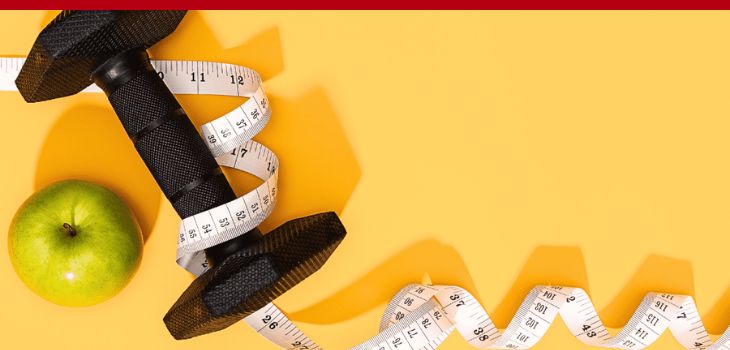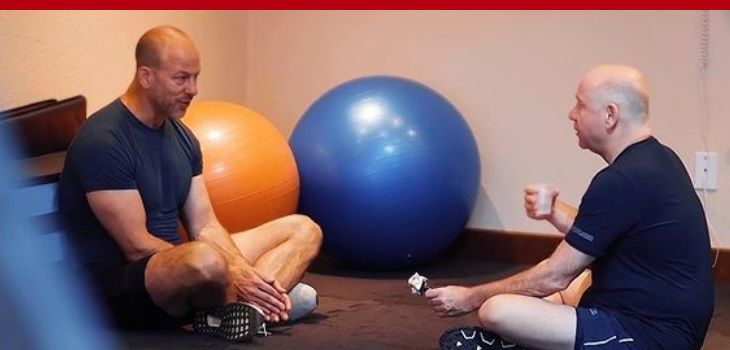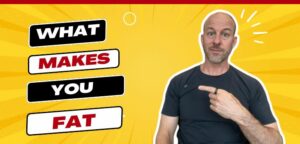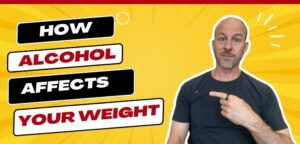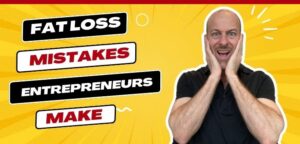by Ted Ryce
Ted Talk 204: The Real Reason Why You Are Not Losing Weight: 5 Mistakes You Might Be Making (AND HOW TO AVOID THEM)
by Ted Ryce
by Ted Ryce
Ted Talk 204: The Real Reason Why You Are Not Losing Weight: 5 Mistakes You Might Be Making (AND HOW TO AVOID THEM)
Ted Talk 204: The Real Reason Why You Are Not Losing Weight: 5 Mistakes You Might Be Making (AND HOW TO AVOID THEM)
more
by Ted Ryce
Ted Talk 204: The Real Reason Why You Are Not Losing Weight: 5 Mistakes You Might Be Making (AND HOW TO AVOID THEM)
Have you ever been frustrated after a week of healthy meals and constant workouts that the number on scale stays the same? Or even worse, increases?
When it comes to fat loss, there are so many different paths people follow, most of them advertised by influencers or advertising campaigns. People see them and follow them step by step to achieve their goals.
But sometimes that doesn’t work.
Why?
Maybe because you are making one –or more– crucial mistakes.
In this episode, Ted explains 5 common weight loss mistakes, why not to fall for them and what to do instead. Listen now!
You’ll learn:
- The real reason why you are not losing weight
- The importance of having the right fat loss strategies
- 5 common fat loss mistakes:
- Mistake #1: Focusing on eating healthy
- Mistake #2: Changing up your workout routine
- Mistake #3: Using the scale
- Mistake #4: Overestimating how many calories you burn
- Mistake #5: Cutting too many calories
- Effective fat loss strategies to help you get long term results
- And much more…
Related Episodes:
Ted Talk 159: 5 Mistakes Entrepreneurs Make with Fat Loss (and how to fix them!)
474: 7 Fat Loss Lies You Need To Stop Believing with Ted Ryce
Ted Talk 200: Why Clean Eating Isn’t The Magic Fat Loss Bullet You Think (And What to Do Instead)
Links Mentioned:
Sign up for my Unstoppable After 40 Newsletter
Watch My FREE Body Breakthrough Masterclass
Want some help building your best body ever?
Here are 3 ways I can assist whenever you’re ready.
1) Sign up for my Unstoppable After 40 Newsletter and get an email every Friday with tips and strategies on how to transform your body and reclaim your health in record time.
2) Want to learn the simple 5-step process my high achieving clients over 40 are using to skyrocket their energy and build younger, leaner bodies while enjoying life?
Watch my brand new Unstoppable After 40 Masterclass.
3) Work with my team and me directly to reclaim your health, lose fat, and get into the best shape of your life in 2023.
Marvel at the testimonials here first, then schedule your call.
Podcast Transcription: The Real Reason Why You Are Not Losing Weight: 5 Mistakes You Might Be Making (AND HOW TO AVOID THEM)
Ted Ryce: Have you ever wondered why fat loss is so difficult? Well, I’m here to tell you, it’s because you’re making mistakes. You’re just not doing it right. It’s not your metabolism. It’s not your age. It’s none of those excuses that you’ve been using; you’re simply not doing the right strategies.
And in this Real Talk Friday today, we’re going to dive into the five biggest fat loss mistakes that I see people making. Now, I’ve been in this business for 23 years, and I’ve heard a lot of excuses over the past years I’ve been in the business, past couple of decades. And these five mistakes are the ones that are the most common that I see people make when they hop on a call with me or when they reach out to me on social media.
So, if you want your fat loss journey to be easier, you’re going to want to listen to this episode.
What’s up, my friend? Welcome back to the show. And if you’re new, welcome, I’m your host, Ted Ryce, coach to executives and entrepreneurs. So, let’s dive right in.
Mistake number one, focusing on eating healthy food. Ah, what are you talking about, Ted? That doesn’t make any sense at all. Well, I’m here to tell you, it does make complete sense., so stick with me. One of the biggest epiphanies that I had on my personal fat loss journey was this: you can get fat from eating healthy food. Why? Because all food has calories in it, all food has calories in it.
And in the past, I was 100% sure that if I could just eat super clean, if I could just eat whole foods like a paleo-ish diet, that it would be impossible to gain fat—except I got fat.
And this is the biggest mistake I see people making. They feel like if they could just eat cleaner—that’s what we call it, eating clean—that fat loss would be just so easy. That it’s really not a big deal that you’re eating a 16-ounce ribeye steak because it’s grass-fed and finished so it’s okay.
And hey, the fats are healthy, and you can’t get fat from eating healthy fats, right? I mean, that’s just insane. I used to believe that. You’re probably there right now, or maybe on the same line of thought.
And I’m here to tell you, nothing could be further from the truth, especially if you want to get down to very lean levels. And we’re talking under 15% for men and under 20% for a woman, the calories of everything that you eat, except maybe fibrous vegetables, matter.
So, if you’re having a large potato versus a small potato, if you’re having a 16 ounce ribeye steak, versus an 8-ounce or a 6-ounce steak, you have to get this through your head, because if you don’t, you’re going to be squandering your efforts because you can be eating very healthy, and putting a lot of olive oil on all your salads...
I know people like this, this might be you, you’re pouring that all oil on, you’re like, “No, there’s nothing wrong with this. In fact, the more olive oil I eat, the healthier I get, because I read some stupid blog post.”
And again, the blog post was stupid. I used to be there. I used to even kind of take shots of olive oil every once in a while or spoon feed myself coconut oil, because I’m like, “No, this is healthy fats.” Hopefully, I don’t get any problems from doing that later down the road.
But let’s talk about what to do instead.
Even if you’re eating clean, I want you to track your food for a week to give yourself an idea of how many calories are in the foods that you’re eating, not anyone else is eating or the foods that you think you should eat, just the foods that you’re eating.
That’s why I love tracking so much. It’s agnostic when it comes to diet, it’s just the truth about what you’re doing. It’s like looking at your bank statements. There’s no emotion there. It’s just, this is what you spent your money on, this is how much money you put in the bank, there you go. So track your food for a week to give yourself an idea of how many calories you’re eating.
Number two, changing up your workout routine. In fact, I was going to do a post on it earlier for a future Real Talk Friday. And I just wanted to see what people are saying out there about changing up your workout routine, just to get an idea of—I know what I think but I like to see the presentation. And what I found just was shocking.
I googled, “Why should I switch up my workout?” and over 200 million results. Not 200, not 200,000, 200 million results came up! And, of course, I only looked at the first page and it was terrible advice, terrible! A couple of the things that they mentioned, were like, well, you want to change up your workout routines because you can get repetitive stress injuries. Okay.
And the other thing that they said that was good, a couple articles on the first page, that it can help you if you’re getting bored, if your workouts... Okay, I can see that. Now, here’s the truth.
The key to results is sticking with your routine long enough to perform more reps on an exercise with the same weight and to eventually add weight.
In other words, it has nothing to do with muscle confusion, it has nothing to do with changing up your routine to shock your muscles or getting better results. That’s all total bullshit! And I mean, total! I don’t mean 93% or 80/20%. I mean 100%. I was going to say "pershit", because that’s kind of what it is. It’s 100% bullshit, folks. Why? Because I said so, because I’m like, I figured it out? No, people have done research studies on this.
And some of the best results I ever got—if you look at the thumbnail for this podcast, is when I got in shape in Bangkok. I was basically doing the same routine for a few months. But part of that routine was doing Muay Thai boxing in Thailand.
But when I really transformed my body in 2020, when I was locked in a room in quarantine in Colombia, I was doing the same exercises for over four months, same exercises four months. What was I doing that was different? It wasn’t trying to confuse my muscles, it was trying to add more reps. Every time I did the workout, I tried to do more reps, just one more rep than what I did last time.
Now, of course, using good technique, I should say, the form is super important. If you’re looking like a newborn gazelle, who’s trying to walk when you’re performing your exercises, you need to check your technique. That’s not what we’re talking about here. But we’re talking about with good technique, trying to squeeze out another rep.
And once you do that for a couple weeks, try to squeeze out another rep, try to squeeze out another rep, try to squeeze out another app, do that for maybe two to three to four weeks, then that’s when you add some weight, and then you hit whatever reps you get for that weight.
And then the next workout, you try to squeeze out one more rep, you try to squeeze out another rep on the next workout and so on and you add a little bit more weight. And that is how you transform your body.
And if you’re making the mistake of changing things up because you need to shock your muscle because you’re not getting sore anymore. Guess what? They’ve done studies on this, there’s no correlation between soreness and results. In fact, what they found is either no correlation at all, or an inverse correlation. In other words, it makes you perform worse, because you’ve damaged your muscle so much you feel sore.
Now you feel maybe a little pumped after that. But guess what, that pump, that’s not muscle growth, that is inflammation of your muscles. Muscle growth is actually laying down new muscle fibers. And it doesn’t happen just because you got sore after one workout. The soreness goes way. I’m never sore in my upper body. I got a little sore the other day from my lower body, but I’m never sore with my upper body, never sore.
And I hate being sore, because I feel like if I’m sore that’s going to stop me from making progress, it’s going to take too long. I want to train in a couple days.
So, here’s what to do, definitely: write down your workout, write down the reps and weight on your workout on every workout for the next three months and make sure you’re adding a rep here there.
It’s not always going to happen. I’m not always able to add reps if I had a bad night of sleep or I’m a bit stressed. But in general, the reps that you’re able to do with the same weight should trend upward. It may look like the stock market going up. Hopefully, it doesn’t look like the crypto but it should look a little bit like Apple stock or whatever, Tesla whatever, it should trend upward.
Same thing with the weight you’re using, it should trend upward. Now what we have—and this what I do personally too, I use the same app that I give my clients, I track my workouts, my clients track their workouts. So, I can look in detail and see like, oh, that’s the number of reps they did with that weight. Is there a trend up, yes or no? That’s what I want you to do differently.
The next big mistake is using this scale to measure progress. One of the most common issues that come up with my coaching clients is the dreaded number on the scale. Clients have told me in the past that they feel good when they wake up in the morning. They feel like they’ve been working hard, eating the right things, tracking their macros, hitting their workouts, adding the reps just like what we talked about tracking everything.
And then they step on the scale, and then number doesn’t match their expectations. Sometimes it might be they’ve lost weight, but thought it should have been more based on all the hard work they’ve been doing.
Sometimes it’ll be up and shift their mood negative, and they’ll get a case of the fuck-it’s.
Other times, they won’t move at all. And there’ll be frustrated because they’ve been putting in so much work and feel like, “Ha, this just isn’t working.”
And as a result, I’ve gone back and forth as a coach about how often I ask my clients to weigh themselves, because if they’re unable to handle the number that pops up on the scale, it can create a domino effect, where they start self-sabotaging.
For example, you step on the scale, you see the number, you feel bad, then you think, “Ah, this is stupid. I should stop doing this. I’m so sick of this. I’ve been working so hard and the scale’s been telling me what I need to know.”And guess what, you skip your workout that day.
Do you see how the feelings cause the thoughts, cause the change in behavior? And then how are they going to feel when they skip the workout? Worse! And what’s that going to make them think about? More negative. Now how is that going to affect their behaviour? I think you get the point. You see the downwards spiral starting.
Now personally, though, I don’t weigh in every day but I weigh in frequently, even after “bad days”. In fact, I spent a day at Universal Studios again, riding roller coasters. Unfortunately, it wasn’t quite as fun. That was my third time in the past few weeks, it wasn’t quite as fun. But it was still a good time, got away from work. I’m working hard here.
But one thing that happened at the park is I tried a Brookie for the first time. You ever hear about those? It’s a brownie and a cookie combination. It’s a brownie with a cookie in it, chocolate chip cookie. Not the most amazing thing I’ve had, but I had to try one, Brookie. How American is that, by the way?
And then I ate also edible chocolate chip cookie dough. There’s a place called Fire Eaters Grill in Universal Studios that has this delicious edible cookie dough for dessert. Everything else there is horrible, by the way.
The euro that’s in that Mediterranean section, but that edible cookie dough, something special, let me tell you, if you’re into that type of thing.
And also had a cookie, like a big white chocolate chip cookie. And the next day I knew the scale was going to be up. So, I stepped on it, it was up a couple pounds. I didn’t take it personally. I just said, “Yeah, it’s not as...Okay.” Now I do that myself because I’m there. So, what should you do? What to do instead.
Well, here’s what we tell our clients to do; use the scale weekly, or maybe even not at all. I gave you an example of some of my clients what they struggle with. And I shared what I personally do.
But what I want you to figure out here is what works for you. So, use the scale. Or if it messes with you too much, one, it’s a sign that you’ve got some internal work to do. So maybe you don’t want to use it at all at first.
What I personally love, and what I get my clients to do is use a DEXA scan monthly. Why? Because I feel if you struggle emotionally with the weight thing, use a DEXA scan because it quantifies not just a change in weight, but it quantifies the fat that you’ve lost and the muscle that you’ve gained. You can also use the scale on a pair of jeans that are hard to fit into.
We use a combination of all the above in my coaching program. The data from different sources, but most importantly, the DEXA scan, are what helps my clients to break their preconceived notions about what the number on the scale actually means.
I’ve got so many stories about this, including I’ve had a female client who gained weight in my group coaching program, when we first started it back in 2020.
And we’ve just opened it up. I’ll talk to you about that in a minute. And she gained weight in my program and she started freaking out. And in the group program, I don’t hop on a one-on-one call with them unless it’s an emergency. And I said, “Listen, I’ll hop on a call with you, but I don’t want to just talk about your emotions. The way you feel is important to me, but I want some data.”
And so, she went and got her body fat tested and you know what? Her weight went up but her body fat went from 22% to 18%. Do you understand? Weight went up, but body fat went from 22% to 18%. What happened? Well, she gained a shit ton of muscle, is what happened. Scale on the weight goes up when that happens. That’s how it works. You gain, you build muscle, it changes the weight. It’s how it works. That’s why you pay for me by the pound.
Anyway, I don’t know if that last part was helpful. But we didn’t need to talk. She was like, “Oh, I feel good.” But because she wasn’t—I want you to think about this—she was not able to, because of her emotional issues with a scale, she wasn’t able to see the fat that she had dropped. Body fat was much leaner, have more muscle, but because she had a story in her head and was focused on that story, she wasn’t able to see the truth.
And the truth is, she had gained muscle, a lot of it because I’ve got some special techniques for clients who are just like, hey… she was a total rockstar total high performer. And she was just like, “Tell me what to do. I want the best results ever.” I gave it to her, and she got awesome results in terms of muscle growth, but totally freaked out about the scale—couldn’t see that it was 100% muscle, and that she had actually lost that because of that narrative going on in her head.
So, what to do instead? Use the combination that works for you and be mindful, if you’re measuring yourself in a way and it’s triggering you in causing that negative spiral of thoughts, feelings and behaviors. You want to stay away from that negative spiral. Anything that triggers you, you’ve got to use a different approach.
All right, then next thing we’re going to talk about is overestimating how many calories you burn with exercise. Have you ever completed a workout, say, a hard cardio session—which, hopefully, you’re not doing this, but...—and you saw the calorie estimation, patted yourself on the back? This is a problem.
In fact, there’s whole business models like Barry’s Boot Camp or Orange Theory—I’m not sure Barry’s Boot Camp actually does this, I think Orange Theory is the one. They strap a heart rate monitor and they try to quantify the number of calories that you burn in a workout. But here’s the thing; the only way to really measure the calories burned during exercise is to put a breathing apparatus on because the way you measure calorie burn is through oxygen uptake.
Your Apple Watch isn’t doing that, your heart rate monitor is not doing that. Those are estimates based on your weight and based on your heart rate, which is really inaccurate, woefully inaccurate, it’s like ‘better not to even pay attention to it at all’ inaccurate, stupidly inaccurate.
So, here’s the only thing that you need to know; it’s always going to be easier to cut out 500 calories from your diet than to burn 500 calories with exercise.
So what to do instead? Stop focusing on the calorie burn with exercise, it doesn’t matter. Instead, focus on what we talked about before building muscle in the gym. Focus on that strength training, doing more reps and adding weight over time. And if you want a bonus, then work on your steps and set a step goal and hit it. 7000 is a good start, 10,000 if you want to be a rock star. If you want to be a super human, then 12,000 to 14,000 a day. So, there you go.
Now the fifth mistake I see people make is cutting too many calories. So when I first figured out that calories were the key to fat loss, I had a great idea. Listen to this idea. Listen to how game-changing this idea is! If it’s all about calories, I’m just going to cut my calories super low. So smart. God, I’m a genius. Except that when I went on this particular diet, and this was the Dukan Diet I wanted to try, eating protein and nothing else.
Did it work? Yes. Did I start having electrolyte imbalance issues? Hyponatremia in other words, dizziness, and eventually, did it lead to panic attacks? Well, also yes. Did it also lead to a stagnation in my weight eventually? Also yes. Now look, you may not be as ridiculous as I am and push a couple months into an extreme diet like that.
But what I see most people suffering from—I was just sharing that story to let you know I’ve made these silly mistakes myself, and that’s how I learned—you’ll probably get hungry, at very least, and suffer with brain fog.
So, it’s not ideal if you’re an entrepreneur or an executive running a company or you’re like in the meeting, and people are expecting you to put out a dumpster fire in the business. And you’re just like, “What are we talking about? My brain needs glucose, it doesn’t have it.” You don’t want that.
Now look, sometimes I’ll use a low-calorie plan for rapid fat loss. In fact, with my new clients. I give them a rapid fat loss plan where they drop in between four to six pounds in the first 10 days. And I also use it for myself every once in a while to balance out over eating, but if I’m honest, I don’t do it that strictly.
For example, when I was eating the brookie and the edible chocolate chip cookie dough, all I did was I used one of those meals that I would use in rapid fat loss, I eat one for dinner, kept my calories super low for the rest of the day. And the next day, I kept my calories a little bit lower. That’s an advanced strategy called Calorie Cycling that I teach my clients.
But what I do instead now is I just use those meals when I’m going to go out to eat or like I just said, I use them to balance the calories.
So, what should you do instead? Well, find the number of calories that gives you steady progress, say about a pound a week of weight loss, and makes you feel good at the same time.
And by the way, just a quick bonus tip there. When I say a pound of weight loss per week, I mean an average of one pound a week. What that means is let’s say you’ve lost two pounds in the first week and nothing in the second, you’re still averaging one pound per week. Are we with each other? So good.
Find the number of calories that gives you steady progress about an average one pound per week and makes you feel satiated at the same time. That’s what you want.
All right, that is it for today. Let me just do a brief recap for you. Number one mistake, focusing on healthy food when what you should do is track your calories for a week, because healthy food also has calories.
Mistake number two changing up your workout routine, because you want to confuse your muscles, but you’re the only one confused about what to do.
So do this instead: write down your workout, write the raps, write the weight, track your workouts for the next three months, don’t change it, make sure you’re making progress.
And I promise you, your body is going to change and you’re going to be so happy. Listen to me, even though sometimes the way I say things might be a little bit obnoxious.
Number three, using this scale to measure progress. I personally use the scale, and I know how to use it. But if you’re having trouble with it, because of the emotions it triggers in you, maybe use the scale once a week, maybe not at all, maybe use a DEXA scan, maybe use a pair of jeans, find the right approach that works for you.
DEXA is the best because it’s really going to help you quantify the data in a way that you’ve never had before. All my clients are amazed when they get their DEXA scan. So, I would just say just do that instead.
And number fours overestimate how many calories you burn without or with exercise. So, stop focusing on the calorie burn with exercise what to do instead is go back to focusing on what I said in number two, adding more reps with the same weight or adding more weight over time.
That’s what’s going to change your body.
And number five is cutting too many calories. Forget about the cabbage soup diet, forget about the Masters Cleanse, forget about all those things.
Instead, find the number of calories that gives you steady progress - an average of one pound per week is good - and makes you feel good at the same time makes you feel satiated at the same time makes you feel like you can stick with it. That’s what to do. That’s what to do differently.
And I want to just briefly tell you that if you are looking to do this on your own, then go take action on what I just showed you.
But if you want some help, we just opened our group coaching, it’s running strong, we’ve got some spots left, if you want to set up a call with me to see if you’re right for it. Or if you’re just interested, if you’re an executive or an entrepreneur, and you want to work with me personally, instead of in a group situation, I have some spots left for that as well. All you’ve got to do go to legendarylifeprogram.com/apply, schedule your 15-minute strategy call just really quick.
This is for people who know the benefit of coaching, you just want to see if I’m the right person, or if my program is the right one for you. If you’re a person, you’ve never worked with a coach before, don’t think it works, get to the point where you’re sick and tired of being sick and tired, all right? I’m only interested in people who are ready to go, ready to take action. And most of those people happen to be entrepreneurs and executives most of the time.
All right, so that’s all I’ve got to say. Make sure you put this into action. What’s the biggest takeaway from today, especially? Go put that into action. Go crush it in 2022. Don’t expect COVID to go away, expect things to stay a little weird for a while and just accept it and let’s all win together and make this the best year, even despite all the silliness that might happen. Love you lots, speak to you on Monday, and talk to you then.
Sign up to receive email updates
Enter your name and email address below and I'll send you periodic updates about the podcast.



